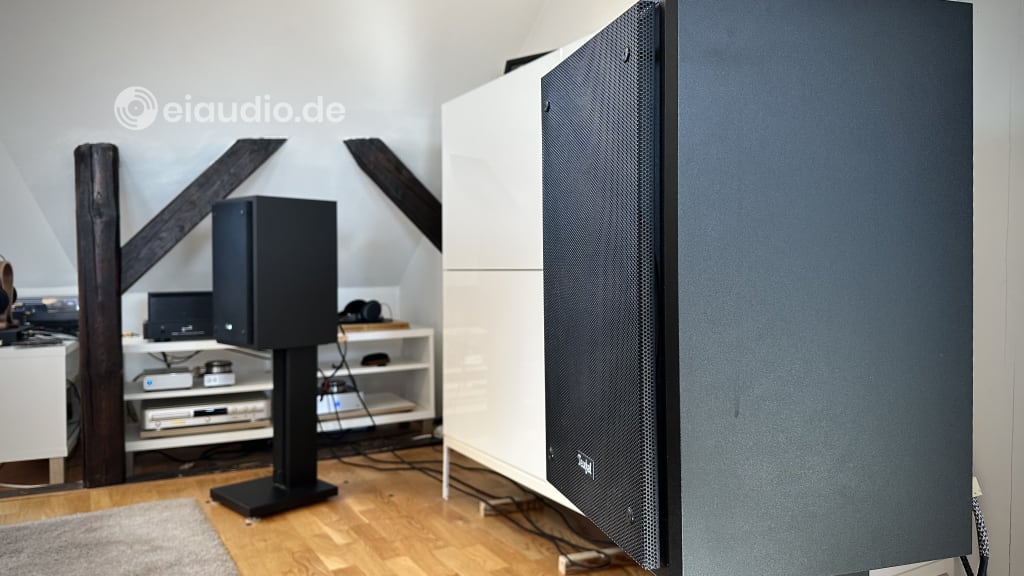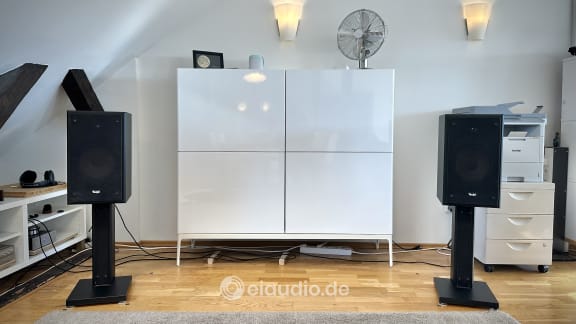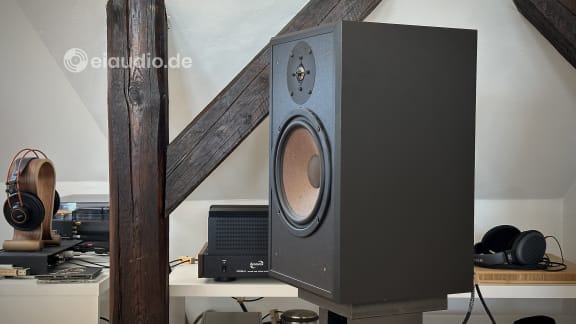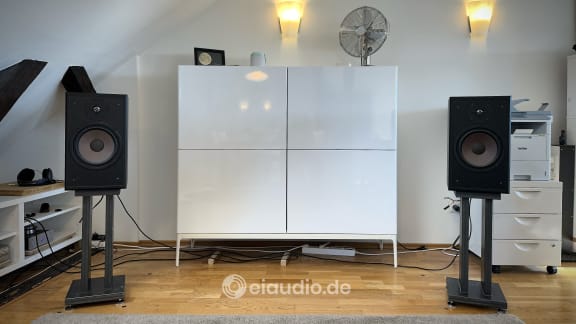Teufel M200 (Basic Module)
Published: 12/03/2023
Manufacturing date: 1988
Author: Karsten Hein
Category: Gear & Review
Tag(s): Loudspeakers
In November 2022, I tested a pair of Duevel Planets loudspeakers. They were of omnidirectional design and surprised me with tonal accuracy and excellent stage imaging. When their owner, Alexi, shared my test with his audiophile friend at work, Michael wondered if I might be interested in testing yet another German HiFi legend, namely, the first loudspeakers ever sold by the German loudspeaker manufacturer Teufel. Since I only knew the Teufel brand from the mid-Fi gear sold in department stores, I was a little sceptical at first. However, this changed when Michael sent me a German HiFi Vision magazine test from August 1988, in which the small Teufels were put up against massive floor-standing speakers from HiFi royalty: Cabasse (model: Brigantin VI), MB Quart (3200 S), and Pilot (Concorde MK IV). It may have helped the test a little that the M200 were played in conjunction with their 56 kilos M6000 compound-bass module. On the other hand, reaching top scores among these speaker manufacturers was more than impressive for a newcomer.
Founded by Peter Tschimmel in 1979, the Berlin-based Teufel had established a name for itself as speaker kit manufacturer, offering selected combinations of crossovers, drivers, and cabinets to its customers. The M200 Basic Module and M6000 Bass Module were the first ready-to-play loudspeakers by the young company. In them, Peter Tschimmel combined the best of what he understood about crossovers with top-of-the-line driver technology. Tschimmel knew that phase alignment and natural tonality were key criteria to be addressed in loudspeaker manufacturing. He was a relative pioneer with his idea of keeping the subwoofer separate from the Basic Module to allow for easier placement of all units in the living space. The M6000 subwoofer itself sacrificed some of its sensitivity to a new compound design that positioned one channel’s bass driver behind that of the other channel to create a pneumatic buffer between them which served to cut the output frequency in half. Due to this effect, the M6000 naturally cut in just under the rated 50 Hz drop-off frequency of the M200 Basic Module, thus extending its range down to 20 Hz.
The M200 were cleverly constructed, reducing cabinet resonances through internal bracing and still not suffocating the sound by using MDF all around. While the front plate was made of MDF, the rest of the cabinet was constructed with 22mm chipboard in support of natural tonality. The midrange-bass and sub-bass drivers were made of paper by the German components specialist Isophon which had not too long before been taken over by Bosch/Blaupunkt. Isophon was among the most innovative speaker driver manufacturers of its time, and the M200 / M6000 chassis still have a good reputation in the HiFi industry. Tschimmel's understanding of crossovers was excellent, and the M200 showed some welcome features for serious bookshelf speakers of the time: 1. proper binding posts that were able to take bananas or spades, 2. a single diameter of allen key screws to fasten all driver chassis as well as the grille, and proper loudspeaker stands to support the Teufel's High-End claim, especially to those customers who were willing to look for and experiment with the ideal room placement.
The frameless speaker grilles were made of rigid perforated sheet metal and allowed for ultra-wide dispersion. Depending on one’s listening tastes, one might find that the speakers sounded better with the grilles taken off. The act of taking the grilles off, however, could be a little tricky because of the four spacer sleeves keeping the grille from touching the speaker front. One had to be careful not to loose them while the grilles were removed and stowed away. After all, the spacer sleeves were made of simple black plastic and, especially when found out of context by some other member of the household, did not look like anything worth keeping.
When Michael and I first set up the M200 Basic Module in my listening space, I was a little confused by the fact that the familiar stage impression of a singer in the middle and the instruments placed around did not want to materialise. Instead, it sounded as if there were two singers simultaneously singing the same song. Inverting the polarity of one channel changed the impression only slightly. It was not until Michael had gone home that I opened both speakers to have a look inside. While one of them looked to be in original condition, the other seemed to have been repaired along the centric spider. The polarity had been handwritten on the magnets by Tuned Systems in Frankfurt am Main. In doing so, the service technician seemed to have confused the poles, and, since they had been given only one of the two speakers for repair, had been unable to notice their error.
I corrected the polarity and found that the sound stage had much improved. When I called Michael to tell him about my findings, he remembered the story of the repair, and we both laughed at the improbability of such a mishap from a professional speaker repair service. And, as Michael had only been running the speakers as rear channels on his surround system following their return, he had never had the chance to notice the inversion, believing that the resulting sound was part of the rear channel effects. Needless to say, the polarity inversion of one midrange-bass cone had contributed to an elimination of bass frequencies and an over-representation of treble, a fact that would have remained hidden on most surround systems that use an additional subwoofer for this job and cut low frequency output on the rear speakers.
I first hooked up the M200 Basic Module speakers to our upstairs system that consisted of a CD source, DAC, solid-state preamplifier and a tube power amplifier (see details below). The Teufel 2-way bookshelves had been given to me for testing without the M6000 subwoofer, which was deemed too heavy for transport and not worth the hassle. In fact, the original HiFi Vision testers of the Teufel system had come to the conclusion that the Basic Modules alone did a splendid job, even when playing without the bass. I did, however, receive the original Teufel stands, which should have been well-matched with the properties of the speakers. My first impression was that the stands looked a little frail to properly support loudspeakers of 14 kg with strong bass drivers. Their center column only consisted of four sheets of MDF with bent metal grilles between them on front and rear that would also act as cable duct for the speaker cables.
Resonances from the speakers could be felt along the front grille and all the way down the shaft of the stands, even when the speakers were playing at moderate volume. Michael had placed four thin rubber pads under the stands which I would have preferred to replace with spikes and coasters. I did, however, notice that the M200 could all too easily sound light and analytical if proper coupling towards the ground was not assured. Placing the M200 on our own DIY-MDF stands did not produce a desirable result, which was most likely due to the felt pads that I had placed on top if the stands. The M200 surfaces were a little too slippery to be fully stabilised by felt. Michael had installed rubber pads on top of his original stands which worked better in this position. Yet, somehow, I could not shake the feeling that improved stands and coupling towards the ground would also have produced better-sounding speakers.
The M200 were of a closed cabinet design and needed to be placed relatively close to the front wall of the listening room to assure natural tonality (without the aid of a subwoofer). When I started out in the original position of our EPI 500 speakers, the M200 sounded too airy. Moving them closer to the wall improved the bass foundation. I ended up sufficiently happy with the drivers being 70 cm from the front wall, forming an equilateral triangle of 200cm with the listening position. Although moderately rated at 87 dB, these speakers had the ability to easily entertain a large room. Measuring 9 x 11 meters, our upstairs listening room was such a large space, and the M200 sounded controlled and present in the whole room and even in the adjacent rooms downstairs. I have always been able to judge the quality of a system from outside the listening room and have presented many examples of this phenomenon in my articles. The M200 were yet another case in point, by making music sound similar to a live event when I was not in the same room with them.
Having critically listened to loudspeakers for some years, I had come to prefer Vocal Jazz for basic analysis. The human voice was an important component of music, and speakers that excelled in this discipline were usually instant favourites in audiophile circles, even if other categories were not as convincing. The M200 rendered vocals faithfully, albeit with a touch of Teutonic soberness that, at times, bordered on analytical. The Teufels were able to present a wealth of acoustic information, if soundtrack and speaker alignment permitted. However, I never had the impression that this was at the cost of musical cohesion. Whilst painting in slightly cooler tones than our Epicure speakers, the music still seemed sufficiently rich in colour.
The Teufels depicted drums and brass sounds in natural colours. When it came to double bass and string instruments, I preferred the subtler, slightly less frontal sound of our Epicure and Martin Logan speakers. Listening to live music worked great with the M200. In faster passages they could show the agility of the paper cone within a closed box. Bass was try and punchy where the music required it. Some passages would have benefitted from the Bass Module for improved realism. However, in this respect, the Teufels did not really lack in terms of bookshelf speakers. In fact, they did not sound much like bookshelves at all. With my eyes closed, I would have imagined them to be much larger and more complex. It was a real surprise to have this much vigor coming out of a relatively small speaker system.
To my ears, the M200 sounded better at greater distance than at close range. The treble appeared to be most natural with the tweeter axis directed to a spot at about 1/3 past the listener’s head. The M200 did not benefit from parallel placement with the room’s front walls and, in my setup, sounded most balanced at a slight toe-in. In terms of soundstage, I found the Teufels to play wider than I was used to from our previous speakers. While this might speak for exceptional channel separation from our system in the eyes and ears of some listeners, I was a little concerned about the obvious lack of stage depth. Although I moved the speakers around the room to try different positions, I was not able to eliminate this phenomenon. At times, the singer seemed to trail off to either side, as if there was some unforeseen bending of phase involved.
I did not listen to the speakers without the metal grilles in place, and it was possible that the lack of stage depth was somehow caused by the grilles interacting with the direct sound waves from the drivers. It was also possible that the plastic tweeter refractor ring interacted unfavourably with the tweeter’s direct energy, or that the resulting time-smear was a result of both. As the tweeters were ferro-fluid cooled, hardened ferro-fluid could have been blocking the propagation of the dome in some undesirable way. And, finally, it was possible that the stands themselves would have required better support in order for the speakers to remain still.
I decided to test the Teufels in other combinations and will report here. Michael suggested that I try a beafy solid-state amplifier with them, instead of our 2x 40 watts tube amp. Well, we shall see...
Test system (1): Marantz CD-17 CD-Player via HiViLux Reference SP/DIF cable on Cambridge DAC Magic 100 via HBS Silver Solid-Core Interconnect on Restek V1 preamplifier via HBS Silver Solid-Core Interconnect on Dynavox VR-70 tube power amplifier via Belden 9497 speaker cables in single-wiring on the loudspeakers.
My second upstairs system consisted of similar components as the first, using a CD player as source and feeding into a pre and power amplifier combination. Only, this time around, the individual units, as well as their interconnects, were of a more basic quality. In fact, the power amplifier was the only exception in the line-up, having been especially designed for eiaudio and the purpose of audiophile listening. It offered excellent signal damping, had low-Ohms capabilities, and was able to churn out 150 transistor watts per channel into 8 Ohm loads on the basis of a 500 VA power supply. I was eager to find out how changing the electronic and physical environment would affect the M200's musical performance.
Both the Rotel preamplifier and the speaker cables were more forgiving components, which worked in favor of the more analytical Echle LF-3519 transistor amplifier, which could be ruthless when it came to uncovering faults in the system. The resulting mix of properties had worked well on our Epicure 3.0 speakers which had previously played in the same position. At this end of the room, there was a sloping wall behind the speakers that made for a mild horn effect. This was arguably not the best possible placement, but the best I could do for comparison.
In this new position, the M200 could show that they were more than ordinary bookshelf speakers. I was happy to find that they managed to work nearly as well in front of a sloping wall as they had done in front of a straight one. The Echle solid state amplifier offered almost four times the power reserves of the Dynavox tube amp, and yet, the speakers still sounded very similar and recognisable. The tubes had presented the music with a little more gravitas, whereas the Echle LF-3519 amp sounded a little tighter in the bass and offered generally more bass control. The treble seemed a bit cleaner and crisper on the Echle amp, but tonal colours were more enchanting on the tube amp. Both amps made for a musical experience on the M200 speakers.
The one aspect that still troubled me, however, was the impression of mono-signals trailing off to the sides at times, thus adding a slight stereo artifact around the singers vocals. Being unused to this phenomenon, I automatically found myself turning my head towards the respective speaker each time it happened. One could shurely get used to it, and less discerning listeners might not even have noticed. However, it did affect stage depth, and it would have been interesting to find out what was causing the phenomenon. Irrespective of this, I would have liked more listening distance to the speakers to achieve a less sharp-sounding sound image. In my listening tests, the M200s became really interesting from a diagonal of 3.00 metres.
Test system (2): Denon DCD-1420 CD player via Wireworld Luna 7 on Rotel RC-960BX preamplifier via HBS Silver Solid-Core Interconnect on Echel LF-3519 power amplifier via Oehlbach standard 4mm copper speaker cables on the loudspeakers
Specifications
M200 (Basic Module)
- Type: 2-way bookshelf loudspeaker (MK-I, 1988)
- Principle: dynamic drivers in closed cabinet
- Cabinet: 22mm fine chipboard and MDF, internally braced
- Nominal impedance: 8 ohms, without M-6000 subwoofer
- Power handling: 200 watts (RMS), 500 watts (peak)
- Recommended transistor amp (min): 60 watts into 8 ohms
- Power efficiency: 87 dB
- Frequency response: 50 Hz - 22,000 Hz (-6 dB)
- Crossover frequency: 1,600 Hz
- Slope: 12 dB per octave (phase aligned)
- High-frequency driver: 25mm dome by LPG, titanium (ferrofluid cooled)
- Midrange-to-bass driver: 20cm Isophon, paper pulp
- Connection panel: single, for bananas or spades
- Dimensions: (W) 270mm; (H) 460mm; (D) 280mm
- Weight (each 2-way basic module alone): 14 kg
- Accessories: M6000 subwoofer module (< 50 Hz)
- History: first ready-made loudspeaker by Teufel
- Development and construction: Peter Tschimmel
- Country of manufacture: Germany, Berlin
- Year(s) of manufacture: MK-I 1988 - 1992 (MK-II 1992 - 1996)
M6000 (Bass Module)
- Type: stereo subwoofer in ported cabinet (MK-I, 1988)
- Principle: 2 dynamic drivers in compound position
- Cabinet: 22mm fine chipboard and MDF, internally braced
- Nominal impedance: 4 ohms, with M-200 basics
- Power handling: > 200 watts (RMS), 500 watts (peak)
- Power efficiency: 87 dB
- Frequency response: 20 Hz - 50 Hz
- Recommended transistor amp (min): 80 watts into 8 ohms
- Upper crossover frequency: 50 Hz
- Slope: 12 dB per octave (phase aligned)
- Sub-bass driver: 2x Isophon PSL 320/400, paper pulp
- Connection panel: single, for bananas or spades
- Dimensions: (W) 410mm; (H) 630mm; (D) 520mm
- Weight: 56 kg (70 kg with one basic module)
- Accessories: M200 basic module (> 50 Hz)
- History: first ready-made subwoofer by Teufel
- Development and construction: Peter Tschimmel
- Country of manufacture: Germany, Berlin
- Year(s) of manufacture: from 1988
M200 (Speaker Stands)
- Type: loudspeaker stands
- Dimensions: (W) 275mm; (H) 500mm; (D) 300mm
- Base plate: (W) 275mm; (H) 500mm; (D) 30mm (MDF)
- Top plate: (W) 220mm; (H) 2mm; (D) 220mm (metal)
- Column, hollow: (W) 100mm; (H) 46mm; (D) 100mm
- Weight (each stand): 4.4 kg
- Development and construction: Peter Tschimmel
- Country of manufacture: Germany, Berlin
- Year(s) of manufacture: 1988 - 1992






